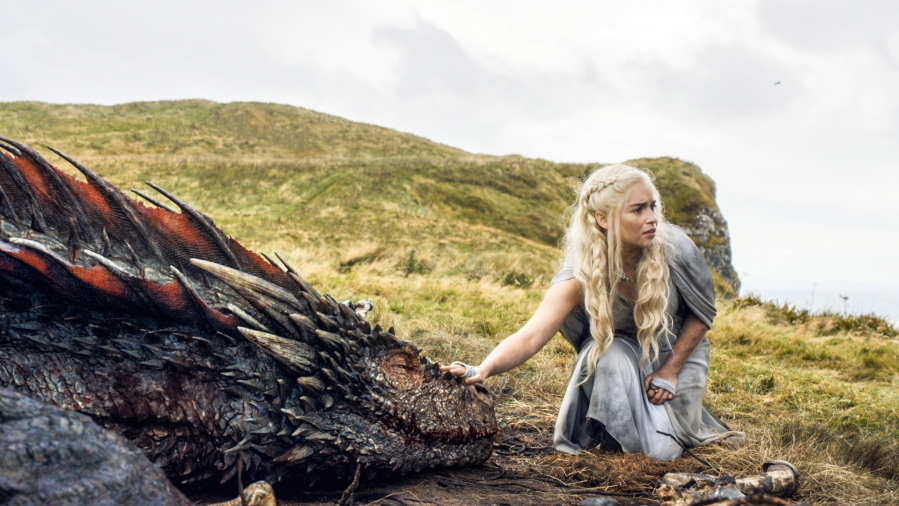WASHINGTON — From the North comes an army of ice zombies. From the East, an armada led by the “Mother of Dragons.” In the South, an evil queen plots world domination.
The world of “Game of Thrones” may not sound much like our own. But after watching HBO’s hit series for six seasons, we’ve found some striking similarities.
The lords, ladies and common folk of Westeros are confronting some familiar-sounding problems: Only the wealthy seem to stay afloat financially, no matter how reckless they are. Gridlock, infighting and incompetence define the government. Many in power turn a blind eye to the existential threat of climate change.
As fans count down the days to the HBO series’ seventh season, scheduled to begin July 16, The Associated Press is looking at the show through a unique lens: Its economy.
Listen to our new online audio series, “The Wealth of Westeros.” (soundcloud.com/user-186673023/sets/wealth-of-westeros-the-economy) Every week, we’ll be diving into the latest plot twists and analyzing the economic forces driving the story.
Even in a world with magic, dragons and deadly supernatural White Walkers, the popular show has plenty of economic lessons. Here are five key takeaways:
• THE IMPORTANCE OF BANKS: Most fans know about the Iron Bank of Braavos. It’s so secretive and powerful that Goldman Sachs looks like an investing club for elderly retirees by comparison. But rather than open a branch in Westeros, the Iron Bank operates across the Narrow Sea in Essos. This effectively leaves all of Westeros without a major bank — which makes it harder to save money, borrow for wars or even invest in businesses that would hire and innovate.
After the 2008 financial crisis, many Americans naturally thought of bankers as villains. But Westeros shows the trouble of a world without financiers or transparent lending — debts forever build for governments, while few citizens are able to invest in themselves.
• STAGNANT ECONOMIES WERE THE NORM FOR CENTURIES: In the United States, the economy is growing at only 2 percent, instead of its post-World War II average of 3 percent. That’s sparked political controversy and contributed to the rise of politicians like Donald Trump and Bernie Sanders.
Westeros wishes it was so lucky.
Westeros appears to have made zero economic progress over several centuries and has arguably regressed. During 300 years in the United States, people got indoor plumbing, electric lights and cars. But Westeros’ experience is much closer to human history. Data tracked by the late economist Angus Maddison suggests that growth in Western Europe from 1000 to 1500 AD averaged a barely there 0.3 percent a year.
• MAGIC ISN’T HELPING INNOVATION: Westeros has seen little technological progress over its previous 8,000 years. That’s strange because developing airplanes or ballistic missiles would be a natural counter to a fearsome beast like Drogon, the biggest dragon on “Game of Thrones.”
“The existence of these weapons should spur an offsetting arms race,” says Lyman Stone, an economist who has written extensively about the show.
But in Westeros there appears to be a shortage of proven technology, let alone research for new tools. No one appears to have mass produced Valyrian steel or dragonglass — two materials that can kill the White Walkers.
• WHERE VIOLENCE OCCURS, GROWTH SLOWS: In “Game of Thrones,” entire societies live mostly by plundering others.
Adam Smith, the godfather of modern economics, says violence in medieval societies killed off growth. Anyone who thrived, he noted, would become a target for parasites like the Greyjoys.
Barry Weingast, a political scientist at Stanford University and senior fellow at the Hoover Institution, found that the poorest 10 percent of nations experience a coup, on average, nearly every year.
Of course, some wars can lead to faster growth by sweeping away old social and economic structures and spurring innovation. But that hasn’t happened in Westeros. The same families — the Starks, the Tyrells, the Lannisters — have held onto the bulk of wealth and power for centuries.
• THEY’RE ALL IN THIS TOGETHER, WHETHER THEY KNOW IT OR NOT: There’s an army of ice-zombies coming with the White Walkers, but most of the lords and ladies of Westeros can’t be bothered. They’re too busy with jousting tournaments, pleasure houses and fine wine — or scheming to grab the Iron Throne for themselves.
Economists call this a “collective action problem” — a situation in which everyone faces the same threat, but no one individual has an incentive to address or even admit the problem. Those who let others sacrifice to solve common problems are called “free riders.”
Charli Carpenter, a political scientist at the University of Massachusetts-Amherst, has called “Game of Thrones” “a collective action story.”



